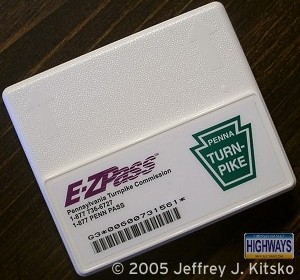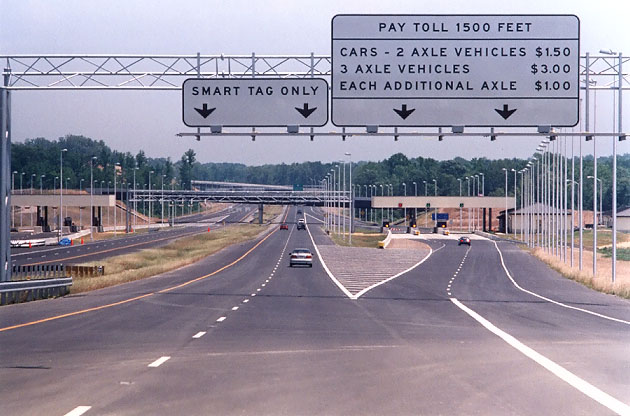Turnpike Raises Tolls, Neglects Toll Plaza Congestion
It will be a merry Christmas and very happy New Year for the West Virginia Turnpike, but not so for those who travel it. Today, the West Virginia Parkways, Economic Development, and Tourism Authority raised tolls for each of the 3 mainline toll plazas from $1.25 to $2 for cars and from $4.25 to $7 for tractor-trailers. Rates for commuter passes will remain unchanged.
The West Virginia Turnpike, like most other toll roads, is not financed by gas tax dollars but instead by the tolls paid by users. One exception occurred when federal funds subsidized the $700 million widening of the West Virginia Turnpike from 2 lanes to 4 lanes between 1973 and 1989. The West Virginia Turnpike's last toll increase was in 1981. Cumulative inflation from 1981 to 2005 was 175% while the car toll increase amounted to 60%.
Like any other entity that sells goods or services--in this case use of the toll road--the West Virginia Turnpike should be expected to provide increased value when it raises its price. While part of this toll increase will finance a six-lane widening in Beckley between I-64 at exit 40 and U.S. 19 at exit 48 and a new interchange to serve the Shady Spring area south of Beckley, Turnpike travelers simply will not receive value to match the higher tolls.
Almost everyone who has driven on toll roads has found the single greatest annoyance with tolls to be the toll collection process. In the 65 years since the Pennsylvania Turnpike became America's first superhighway and first modern toll road, toll roads have collected tolls using either a ticket system or a barrier system. In the ticket system, a motorist would obtain a ticket at the onramp and pay a toll at the offramp based upon the entry point. The barrier system--now used in West Virginia and many newer toll roads--collects fixed tolls at various toll plazas along a turnpike.

Toll collection in the 21st century has advanced to electronic toll collection--and in some cases without the need to stop or even slow down--thanks to E-ZPass and similar electronic toll collection systems. E-ZPass is an electronic toll collection system that uses radio transponders mounted inside a car's windshield, overhead sensors to detect transponders and record transactions, and video cameras to record toll scofflaws that debuted in New York in 1993 and is now used by 11 states from Maine to Virginia and Illinois. Most states issue transponders linked to prepaid accounts that are automatically replenished from an account holder's bank account or credit card; the West Virginia Turnpike only issues E-ZPass to commuter pass holders who pay flat rates for unlimited travel on the West Virginia Turnpike. Many toll roads offer discounts to E-ZPass users; last year, the Illinois Tollway doubled cash tolls for cars and left electronic toll rates for cars unchanged.

E-ZPass states
The most exciting aspect of electronic toll collection is open road tolling--reconstruction of toll plazas to include dedicated lanes for E-ZPass (or other electronic toll collection system) users and cash toll plazas to the side, physically separated from the open road tolling lanes--that allows users of the electronic toll collection system to drive through the toll plaza at highway speed and those who pay by cash to safely exit, stop, pay the toll, and then accelerate to highway speed upon leaving the toll plaza and resuming travel. Open road tolling eliminates the bottlenecks at toll plazas. A manual toll lane can process up to 300 to 400 cars per hour; a low-speed electronic toll collection lane within a traditional toll plaza can process up to 1200 cars per hour. However, an open road tolling lane's capacity is not limited by reduced traffic speeds.

Pocahontas Parkway (VA 895) toll plaza near Richmond, Virginia, featuring open road tolling. The Smart Tag system has merged with E-ZPass since this photo was taken.
West Virginia lags far behind other states in promoting electronic toll collection. While people who have E-ZPass transponders from other states can use them on the West Virginia Turnpike, West Virginians cannot unless they buy a commuter pass for $95 per year per toll booth or obtain an E-ZPass from another state. Dedicated E-ZPass only lanes are only available at certain times, eliminating this small bit of convenience for West Virginia's E-ZPass users during peak traffic periods. At 4 toll lanes in each direction, each toll plaza on the West Virginia Turnpike is effectively limited to 1,200 to 1,600 cars per hour despite significantly higher traffic volumes, thus the frequent, long delays at the toll plazas.
If the West Virginia Turnpike wants to provide increased value for its travelers, it should immediately implement an expansion of its E-ZPass program to include not only commuter passes but prepaid, automatically replenished accounts. It should further reconfigure the toll schedule by charging all E-ZPass users one-half the cash tolls. Transponders should be marketed aggressively based on the successful marketing programs of other states. At each Turnpike service plaza and rest area, motorists should be able to open an account and immediately obtain a transponder; the Pennsylvania Turnpike has automatic vending machines at many of its rest areas. In just one year, the Illinois Tollway has doubled electronic toll payment to 75% of all transactions by implementing the 50% toll rates for electronic payment and initiating a systemwide open road tolling conversion. Without any discount program and before it began conversion to open road tolling, the Pennsylvania Turnpike attained 50% E-ZPass usage within 5 years of introducing E-ZPass.
While this expanded E-ZPass program is a first step, the second step toward modernizing West Virginia Turnpike toll collection and eliminating toll plaza congestion is the reconstruction of the toll plazas and development of open road tolling. Due to the present configuration of the toll plazas, all 3 toll plazas will have to be totally rebuilt. New cash toll plazas should be built on each side of the current toll plazas, which would then be removed for the construction of open road tolling lanes that, when complete, would allow the West Virginia Turnpike's E-ZPass users to drive through the toll plaza at 70 miles per hour and those paying cash to exit the highway for the cash plazas. While this second step will require planning and development, the first phase can be implemented in a very short time frame.
As long as we are going to have toll roads--and it appears certain more roads built in the future will be toll roads given public opposition to higher gas taxes to build freeways--the toll roads should make customer service a top priority and provide real value for motorists' money. Let's modernize toll collection on the West Virginia Turnpike and eliminate the long lines at the toll booths.




<< Home